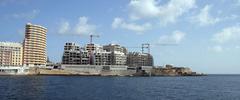
Fort Tigné Visiting Hours, Tickets, and Historical Sites in Gżira, Malta
Date: 24/07/2024
Introduction
Fort Tigné, a historical gem located at Tigné Point in Sliema, Malta, is a magnificent testament to the island’s rich military heritage. Constructed between 1793 and 1795 by the Order of Saint John, this fortification served the vital purpose of protecting the entrance to Marsamxett Harbour, a strategic point for defending Valletta, Malta’s capital city (source). Its polygonal design, revolutionary at the time, marked a significant advancement in military architecture, influencing subsequent fortifications built by the British in the 19th century (source). Over the centuries, Fort Tigné has witnessed numerous historical events, including the French invasion of Malta in 1798 and significant modifications during the British era. Despite suffering damage during World War II, the fort has been meticulously restored in recent years, preserving its historical and architectural significance (source). Today, Fort Tigné stands not only as a monument to Malta’s strategic importance but also as a cultural landmark, offering visitors a unique glimpse into the island’s storied past.
Table of Contents
Historical Background of Fort Tigné
Construction and Early History
Fort Tigné, located at Tigné Point in Sliema, Malta, is a significant historical fortification built by the Order of Saint John between 1793 and 1795. The primary purpose of the fort was to protect the entrance to Marsamxett Harbour, a strategic point for the defense of Valletta, the capital city of Malta. The fort’s construction was partially funded by the Manoel Foundation, which had previously funded the construction of Lembi Battery near Tigné Point in 1757 (source).
Architectural Significance
Fort Tigné is one of the oldest polygonal forts in the world, a design that was revolutionary at the time of its construction. Unlike the traditional bastioned forts, which were common in the 18th century, Fort Tigné’s polygonal design allowed for better defense mechanisms and more efficient use of space. This architectural innovation influenced the construction of many other polygonal forts by the British in the 19th century (source).
Role During the French Occupation
The fort first saw military action during the French invasion of Malta in June 1798. At that time, it was commanded by the Portuguese knight Gourgeau and garrisoned by the Cacciatori, a volunteer chasseur light infantry regiment, along with a few men from the Birchircara militia. The fort surrendered after Grand Master Hompesch capitulated to Napoleon. A French garrison then took over the fort, but it was soon besieged by Maltese insurgents during the subsequent uprising against the French occupation (source).
British Era and Modifications
When Malta became a British protectorate in 1800, Fort Tigné was taken over by the British military. Throughout the 19th and early 20th centuries, the British made several modifications to the fort, including the addition of gun emplacements and barracks. These changes were part of a broader program to improve Malta’s fortifications, as outlined in Colonel William Jervois’s 1866 report, which emphasized the need for enhanced defenses due to the introduction of iron-plated ships and powerful rifled guns (source).
World War II and Damage
Fort Tigné played a crucial role during World War II. It was bombed by the Luftwaffe, resulting in significant damage to its structure. Despite this, the fort continued to serve as a military installation until it was finally decommissioned in 1964 (source).
Restoration and Current Status
In recent years, Fort Tigné has undergone extensive restoration efforts to preserve its historical and architectural significance. These efforts have been part of a broader initiative to restore and maintain Malta’s rich heritage of fortifications, many of which date back to the time of the Order of Saint John. Today, Fort Tigné stands as a testament to Malta’s strategic importance in the Mediterranean and its long history of military architecture (source).
Cultural and Historical Impact
Fort Tigné’s historical and architectural significance extends beyond its military role. It represents a critical period in Malta’s history when the island was a focal point of European military strategy. The fort’s innovative design influenced subsequent fortifications and demonstrated the evolving nature of military architecture in response to new technological advancements and strategic needs (source).
Visitor Experience
Visiting Hours and Tickets
Fort Tigné is open to visitors from 10:00 AM to 6:00 PM, Monday through Sunday. Tickets can be purchased on-site or online. Adult tickets are priced at €10, while children under 12 and seniors can enter for €5. Group discounts are available for tours of 10 or more people.
Guided Tours and Special Events
Guided tours are available daily at 11:00 AM, 1:00 PM, and 3:00 PM. These tours provide in-depth historical insights and access to areas of the fort not open to general visitors. Fort Tigné also hosts special events throughout the year, including historical reenactments and educational workshops.
Travel Tips and Nearby Attractions
Visitors are encouraged to wear comfortable walking shoes and bring water, as the fort has several uneven surfaces and stairs. Photography is allowed, and several spots within the fort offer stunning views of Marsamxett Harbour and Valletta. Nearby attractions include the Sliema promenade, Tigné Point shopping complex, and the historical Fort Manoel.
Accessibility
While Fort Tigné has made efforts to be accessible, some areas of the fort may not be suitable for visitors with mobility issues due to its historical structure. Ramps and handrails have been installed in many areas to improve accessibility.
Conclusion
Fort Tigné is not just a historical monument but a symbol of Malta’s resilience and strategic importance throughout history. Its innovative design and historical significance make it a must-visit site for anyone interested in military history and architecture. The ongoing restoration efforts ensure that future generations can continue to appreciate and learn from this remarkable fortification. Plan your visit today and explore the rich history and stunning architecture of Fort Tigné (source).




